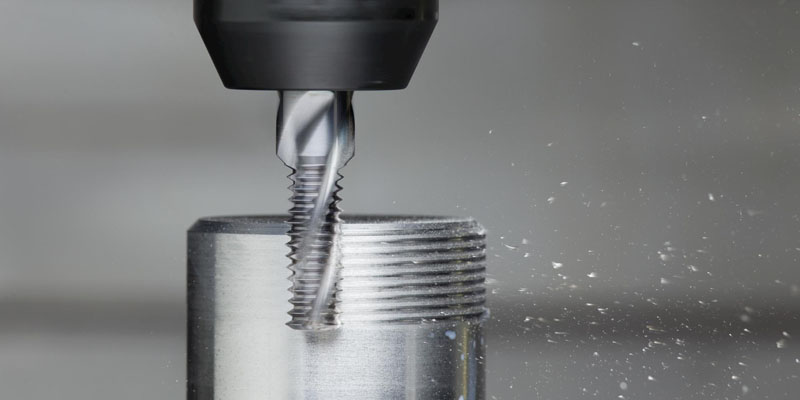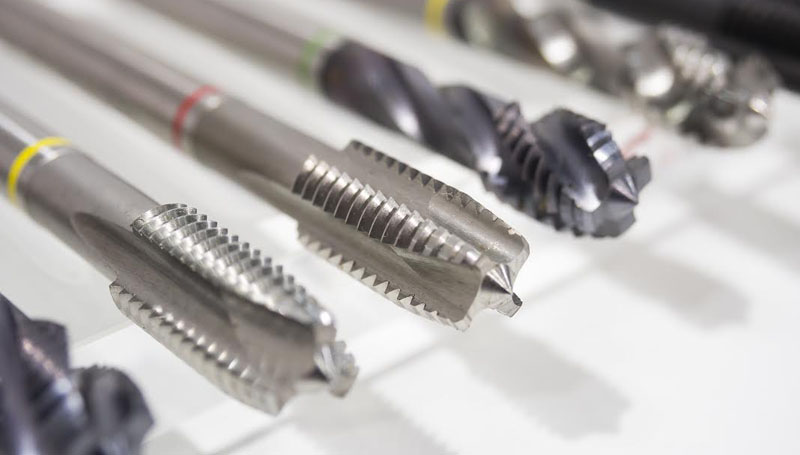Since CNC machining is a subtractive manufacturing method, there is a huge demand for threaded holes in CNC machined parts. Therefore, thread milling or tapping must be used to cut threaded holes in the part.
There are some obvious differences between thread milling and tapping. This article explains the pros and cons of each method so that you can make an informed decision on the strategy that best suits your part. In addition, knowing when to use thread milling and tapping will help produce the ideal threads in your parts.

Thread Milling
The “thread milling” process can cut the internal thread in the hole or the external thread around the workpiece, cutting threads of different sizes through the circular ramp motion of the rotating tool, and the thread pitch is produced by the lateral movement of one revolution. When used to make internal threads, it is different from tapping. It is not a rotating tool, but instead uses a CNC machine to rotate the tool in a spiral or “corkscrew” pattern. With the precision of computer-controlled machines, thread milling cutters can produce almost any type and size of threads according to the required specifications. The machining workshop uses thread milling to process materials such as titanium, stainless steel or hard plastics on large workpieces. Generally speaking, thread milling cutters can produce threads of at least ⅛” (3.175 mm) and about three diameters deep. Although not as widely used as thread turning, thread milling can achieve high productivity in some applications.
Tapping
Tapping refers to the use of a special tool called a tap to cut the internal thread of the workpiece. The tap rotates like an ordinary drill. The cutting edge of a tap is its thread, and the recessed part is called a groove, which is used to accommodate or extract the material removed by the cutting edge. This process has been around for some time and can be done by hand or power tools. Machinists prefer to use tapping technology for high-speed machining of materials such as aluminum and steel. CNC machines, including lathes, drilling machines and vertical milling machines with power tools, use taps to machine threads up to 20 times the diameter.

The difference between threading milling and tapping
The main difference between tapping and thread milling is that the tap is designed to cut a specific thread, while the thread in milling is determined by the controlled movement of the tool. Therefore, the tap is always used to cut the thread to the inner surface, and the thread milling cutter can be used to cut the inner or outer surface. Each method has different advantages and disadvantages.
Thread milling and tapping: comparison of advantages and disadvantages
Both thread milling and tapping can produce threads, but there are differences between the two processes. The following is a breakdown of the advantages and disadvantages of both:
Speed
Tapping is a fast and effective process. For holes of the same size, tapping can be done much faster than thread milling.
The biggest advantage of tapping is speed. The high-speed tapping center set with rigid taps can complete the drilling in a fraction of the time required for thread milling the same hole. In addition, tapping can drill deeper holes in harder materials (such as steel).
Thread milling takes a long time, but the machine controller also spends a lot of time to ensure precision and precision.
Effectiveness
Tapping produces threads in smaller holes, but it requires the use of different taps for each hole size. This consumes a lot of valuable but limited locations in the tool magazine. In addition, having to switch tapping tools for all holes of different sizes increases cycle time. This complexity is accompanied by higher setup time costs. In addition, if the tap breaks inside the part during processing, its removal may damage the workpiece and add more time and expense.
In thread milling, a single tool is used to machine holes of various sizes. This not only reduces tool costs, but also reduces the time associated with tool replacement. In addition, thread milling cutters can process internal and external threads, right-hand and left-hand threads, and very large threaded holes (such as pipe threads). This eliminates the need to invest in large rigid taps to tap large holes, while reducing the investment in various tools and the time and cost associated with frequent tool changes.
Thread Fit
Taps can only create threads produced by the designer. For each additional thread size and pitch the manufacturer needs a different tap. Customized taps can be very expensive and require a long lead time.
And thread milling can use programming in CNC machine tools to adjust the thread size and pitch. This flexibility provides the added benefit of achieving tight tolerances and smooth surfaces. When machining very shallow blind threads of thin materials, thread milling cutters can machine the largest threads in a short distance.
Thread Quality
Tapping tools are the same size as the threads they produce and require a lot of torque to complete the work. This not only causes the tap to break, but also affects the final finish and tolerance of the thread, resulting in relatively low component quality.
CNC thread milling allows precise adjustments to the machining process to produce the highest precision and precision in cutting threads. In addition, thread milling uses a tool smaller than the final thread, leaving enough clearance for the safe discharge of the removed material. Through speed control and careful handling, thread milling cutters can produce high-quality parts with excellent finish.
Blind Holes And Chip Breaking
Common causes of chip breaking include chip overload, and chip removal has always been a problem in tapping. For this reason, the use of taps on NC equipment has been facing the challenge of breakage and thread quality. Another disadvantage is that the tap cannot be screwed into the bottom of the blind hole. Thread milling avoids the difficulties associated with tapping because it not only provides better chip control, but it can also be machined to the bottom of blind holes without hindrance.
Summary
If you need more flexibility, have a range of thread sizes and types, and need the ability to adjust the thread fit, thread milling is the best choice. If speed is your requirement, then rigid tapping is what you need.


